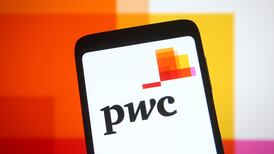It's a measure of the sudden turnaround in AIB's trading performance that Eamonn Hughes, a seasoned banking analyst with Goodbody Stockbrokers, dramatically revised his forecasts for the bank on Monday evening following the publication of the company's first-quarter trading update.
In case you missed it, the bank said it returned to profit in the first quarter of this year while its stock of impaired loans reduced by €700 million.
Hughes originally had a €173 million loss pencilled in for this year but has now revised it to a profit of €216 million for 2014. That’s a hefty €390 million swing into the black. He puts about 20 per cent of the turnaround down to increased income and most of the balance to an improved outlook on provisions.
The improved outlook came just one week after the European Commission approved the bank's restructuring plan. AIB chief executive David Duffy told me this was symbolically important, particularly for the staff as it meant "leaving the past behind and moving on to a forward-looking agenda".
All of a sudden, AIB has a strong wind at its back and there is now a clear expectation building of some sort of privatisation in 2015. It will certainly happen before the next general election, which has to be held by March 2016.
There's a political imperative to this, both to feed the narrative ahead of the next election that Fine Gael and the Labour Party delivered on their promise to sort out the banking sector, and to help grease the wheels for whatever tax cuts the Government has in mind to win back disillusioned voters.
When he took over as CEO, Duffy set out a three-year plan to return AIB to the black and prepare the ground for external investment.
Stress tests
To achieve this, AIB first had to demonstrate its viability to the markets. This has involved getting back into profit (tick),
reducing impaired loans and demonstrating that its debt arrears are being managed effectively (half a tick), and proving the bank is adequately capitalised (jury still out).
The questions around its capital adequacy won’t be answered definitively until the results of the European bank stress tests are published in November. Barring a stumble in the coming months, this hurdle should be cleared.
It will then be full steam ahead to deal with the contingent capital notes and preference shares held by the State.
It will also have to deal with its ordinary share capital structure. There are more than 521 billion AIB shares in issue, which gives it a market cap of about €57 billion. Crazy stuff.
The bank issued an additional 2.17 billion shares to the Government yesterday instead of paying a dividend of €280 million due on the €3.5 billion worth of preference shares held by the State since 2009. This follows a trend of recent years. The State already owns 99.8 per cent of AIB so the issue of more shares is no big deal save for the fact it would be handy to have €280 million available to the exchequer. AIB's trading update on Monday noted a valuation of one times net asset value (NAV) is the rule of thumb for its European peers. AIB is totally out of whack at at eight times its NAV at the end of 2013.
Return to exchequer
The State’s holding in AIB is currently on the books of the National Pension Reserve Fund at €10.1 billion. With the bank now back in profit, this should rise when the next
year-end valuation exercise is completed.
AIB (including EBS) has received a bailout of €20.8 billion. Whichever way you shake it, there’s a large gap still to bridge if taxpayers are to get all of their money back. Timing the sale of a piece of AIB will be crucial to any return to the exchequer.
Investors are hot to trot on Ireland at the minute. We've seen that with Bank of Ireland over the past year or so and with the recent sale of IBRC's €22 billion loan book.
This positive sentiment towards Ireland won’t last forever. Maybe now is the right time to ‘price test’ AIB. You’d hate to miss the boat.












